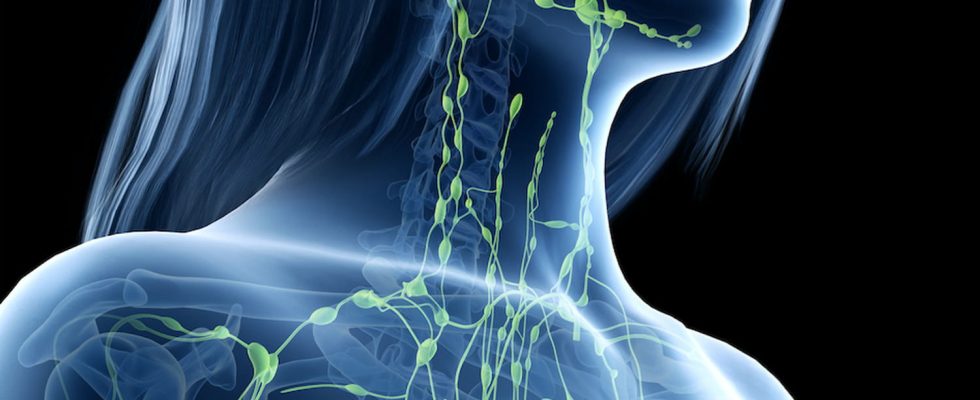With its very complex network of vessels, nodes and organs, the lymphatic system provides a dual function of defense and elimination of waste from the human body. Update in pictures with Dr Bénédicte Bruno, hematopediatrician.
The lymphatic system consists of both a network of lymphatic vessels – who are born in different tissues of the body with lymph nodes called lymph nodes – and organs such as the spleen, thymus and tonsils.
• Lymph
Lymph, whose composition is close to that of blood plasma, contains numerous lymphocytes, a family of white blood cells, produced in the bone marrow, which are responsible for defending the body against external attacks, starting with viruses and bacteria.
• Lymphatic vessels and nodes
The lymphatic system includes the lymphatic vessels. The role of the lymphatic vessels is to transport lymph (yellowish liquid which contains white blood cells and in which the cells are bathed) from tissues to arteries and veins passing through the lymph nodes, which filter it. The two main lymphatic vessels are the right lymphatic channel (2 cm) which connects the right half of the head and the right arm, and the thoracic duct (40 cm) which connects the left side of the abdomen to the base of the neck.
• Lymphatic organs
The lymphatic system consists of primary lymphatic organs, such as the bone marrow where the thymus where the lymphocytes mature, and secondary lymphatic organs like the tonsils or the missed where lymphocytes migrate to defend the body.
The lymphatic network is present from the head to the feet and drains most organs including the lungs and intestine. “It is a kind of network parallel to the network of blood vessels ” explains Dr Bénédicte Bruno, hematopediatrician at the Jeanne de Flandre hospital in Lille. They only communicate at one place in the body: at the level of the thoracic duct which collects the majority of the lymph. The lymphatic vessels pour about 3 liters of lymph per day into the veins through the latter “. Nodes – called lymph nodes – are located along the path of the lymphatic vessels and play the role of sentinels. There are nearly 800 of them in the human body, mainly in the neck, abdomen, thorax but also in the the groin and armpits.
The lymphatic system is essential for the proper functioning of the body. It includes both the network of lymphatic vessels and nodes as well as organs such as the spleen and thymus. “It has a dual function, specifies Dr. Bénédicte Bruno. It is both a defense organ against any substance foreign to the body and an organ for eliminating waste from the body via tissue drainage. The lymphatic vessels will bring any substance foreign to the body to the lymph nodes but also transport immune cells and thus participate in the activation of the immune response. “. And added: “Lymph circulates in the lymphatic vessels thanks to muscle contractions and body movements. This is why physical activity – like walking every day – is essential to stimulate lymphatic circulation! “.
Sometimes the lymphatic system malfunctions. THE lymphedema, for example, is linked to a slowdown in lymph circulation. It can occur following a constitutional anomaly (primary lymphedema) or a surgical procedure such as in the case of breast cancer (secondary lymphedema). Lymphedema mainly affects the arms and legs but can also affect other areas of the body such as the neck. Its treatment then consists of restoring mobility and preventing increased swelling via manual drainage techniques (physiotherapy), the application of bandages or the wearing of compressions. The lymphatic system can also be affected by a cancer: lymphoma. “The discovery of an lymphadenopathy (node) – a lump in the neck, groin or under the arm – should lead you to consult your doctor, confides Dr Bruno. As a first-line treatment and in the absence of other suggestive symptoms such as fatigue, night sweats or weight loss, we can give antibiotic treatment and see if it disappears. Otherwise, it will be necessary to continue the explorations with an ultrasound or a biopsy of the lymph node. If lymphoma is diagnosed – the most common being Hodgkin’s lymphoma – the patient will be treated in a hematology department. This pathology can affect all ages, including children. There are many subtypes of lymphoma – appearing quickly over a few months or developing very slowly – each with a very specific treatment.
When a lymph node is discovered, it is often necessary to carry out a biopsy in addition to ultrasound. This takes place under local or general anesthesia and allows a small piece of lymph node to be taken in order to observe it under a microscope and guide the diagnosis. In the context of breast cancer, a lymphoscintigraphy can also be carried out to look for the sentinel lymph node, before surgery. This almost painless examination – you may feel a slight burning at the time of the injection – takes place on an outpatient basis. The doctor injects a contrast product into different points of the breast around the tumor before taking images using a device called a gamma camera.
Thanks to Dr Bénédicte Bruno, hematopediatrician at the Jeanne de Flandre hospital in Lille.
